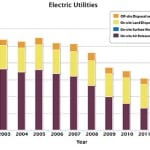On Jan. 14, the Environmental Protection Agency (EPA) published its Toxics Release Inventory (TRI) report for 2013 showing that electric utilities have cut toxic releases to the environment 49% since 2003.
The drop was driven by a 73% decline in on-site toxic air releases as a result of a decrease in hazardous air pollutants (HAP) emissions. In TRI, a “release” generally refers to a chemical that is emitted to the air, water, or placed in some type of land disposal. Most of these releases are subject to a variety of regulatory requirements designed to limit human and environmental harm.
HAP emissions have dropped largely because electric utilities have shifted from coal to other fuel sources and installed new control technologies at many of the remaining coal-fired power plants. In 2003, almost two-thirds of production-related waste was released without treatment, whereas by 2013, approximately two-thirds of the waste was treated. The trend is mostly due to an increase in the number of scrubbers used at facilities to remove acid gases, which will continue as plants upgrade to meet Mercury and Air Toxics Standards.
TRI data is submitted to the EPA, states, and tribes annually by July 1 for the prior year by facilities in industry sectors such as manufacturing, metal mining, electric utilities, and commercial hazardous waste. In the electric utilities sector, only those facilities that combust coal or oil to generate power for distribution in commerce—567 facilities in 2013—must report to TRI.
The electric utility industry continues to account for the largest portion of air releases (26%), and air releases did increase by about 3% from 2012 to 2013, mainly due to increased production at the reporting plants. The full report is available on the EPA’s website.
—Aaron Larson, associate editor (@AaronL_Power, @POWERmagazine)










